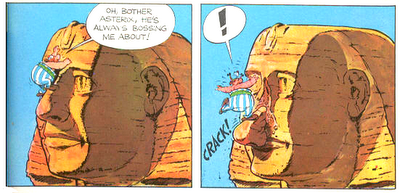Zakaj sfinga nima nosu?
- Ustvarjalec teme veselilisjak
- Začetni datum
Uporabljate neposodobljen brskalnik. Ta ali druga spletna stran morda ne bo prikazana pravilno.
Posodobite brskalnik ali uporabite alternativni brskalnik.
Posodobite brskalnik ali uporabite alternativni brskalnik.
The one-metre-wide nose on the face is missing. Examination of the Sphinx's face shows that long rods or chisels were hammered into the nose, one down from the bridge and one beneath the nostril, then used to pry the nose off towards the south.
The Arab historian al-Maqrīzī, writing in the 15th century AD, attributes the loss of the nose to iconoclasm by Muhammad Sa'im al-Dahr, a Sufi Muslim from the khanqah of Sa'id al-Su'ada. In AD 1378, upon finding the Negroid peasants making offerings to the Sphinx in the hope of increasing their harvest, Sa'im al-Dahr was so outraged that he destroyed the nose, and was hanged for vandalism[citation needed]. Al-Maqrīzī describes the Sphinx as the "talisman of the Nile" on which the locals believed the flood cycle depended.
There is also a story that the nose was broken off by a cannonball fired by Napoleon's soldiers, that still lives on today. Other variants indict British troops, the Mamluks, and others. Sketches of the Sphinx by the Dane Frederic Louis Norden, "View of the Sphinx, near Cairo" made in 1737 and published in 1755, illustrate the Sphinx with a bulb of a nose
The Arab historian al-Maqrīzī, writing in the 15th century AD, attributes the loss of the nose to iconoclasm by Muhammad Sa'im al-Dahr, a Sufi Muslim from the khanqah of Sa'id al-Su'ada. In AD 1378, upon finding the Negroid peasants making offerings to the Sphinx in the hope of increasing their harvest, Sa'im al-Dahr was so outraged that he destroyed the nose, and was hanged for vandalism[citation needed]. Al-Maqrīzī describes the Sphinx as the "talisman of the Nile" on which the locals believed the flood cycle depended.
There is also a story that the nose was broken off by a cannonball fired by Napoleon's soldiers, that still lives on today. Other variants indict British troops, the Mamluks, and others. Sketches of the Sphinx by the Dane Frederic Louis Norden, "View of the Sphinx, near Cairo" made in 1737 and published in 1755, illustrate the Sphinx with a bulb of a nose
Vse kar ste napisali sem že sam našel, vključno u Obelixom.

Do sedaj sem bil prepričan, da so krivi Francozi, pa očitno temu ni tako.

Do sedaj sem bil prepričan, da so krivi Francozi, pa očitno temu ni tako.
Po mojem jih sovraži zato, ker zaradi prevajanja dovoljujejo številne interpretacije prevajalca. Ali pa se je vse začelo s prevodom (izjave Blaira al' koga že) za Bob leta.


Citat:
Uporabnik patriot pravi:
Ne najdem neke pametne razlage...
Pa kako si se lahko spomnil ravno na svingo

Citat:
Uporabnik mistique pravi:
Po mojem jih sovraži zato, ker zaradi prevajanja dovoljujejo številne interpretacije prevajalca. Ali pa se je vse začelo s prevodom (izjave Blaira al' koga že) za Bob leta.
točno to.
ampak obtoži se me pa spamanja.
a ko folk dva sodelavca rečeta, da je en jedel meso, drug pa zelje, se doma sef pohval, d ajejo segedin
I
Izbrisan uporabnik #488
Citat:
Uporabnik patriot pravi:
Ne najdem neke pametne razlage...
Nekje sem bral oz. gledal oddajo, da je Sfinga prvotno imela glavo leva, ker je bila obrnjena v smer ozvezdja Leva. V času gradnje je bilo nebo pač tako obrnjeno (korelacija Sfinge z Levom je 10.500 BC, enako tudi piramide z Orionovim pasom).
Ker je bila glava pretežka za konstrukcijo, se je krušila in so potem glavo zmanjšali na faco faraona. To naj bi bil faraon Kefren.
Najbrž bo isti razlog potem v nosu, da je pač odpadel.
I
Izbrisan uporabnik #488
Aja, ne manjka pa samo nos, ampak tudi brada...
Citat:
Orion correlation theory
The Orion correlation theory, as expounded by popular authors Graham Hancock and Robert Bauval,[21] is based on the proposed exact correlation of the three pyramids at Giza with the three stars ζ Ori, ε Ori and δ Ori, the stars forming Orion's Belt, in the relative positions occupied by these stars in 10500 BC. The authors argue that the geographic relationship of the Sphinx, the Giza pyramids and the Nile directly corresponds with Leo, Orion and the Milky Way respectively. Sometimes cited as an example of pseudoarchaeology, the theory is at variance with mainstream scholarship.[22][23][24]
benti, kake stare babe morjo že not bitCitat:
Uporabnik hrci pravi:
pod sfingo majo kurbenhaus
Podobne teme
- Odgovori
- 49
- Ogledi
- 3.273
- Odgovori
- 5
- Ogledi
- 1.046
- Odgovori
- 34
- Ogledi
- 3.534



